Biophilic Interior Design Restaurants: Creating Natural Spaces for Dining Pleasure
In the bustling world of hospitality, where ambiance plays a pivotal role in enhancing the dining experience, biophilic interior design has emerged as a transformative concept. Drawing inspiration from nature, biophilic design seamlessly integrates natural elements into restaurant spaces, creating environments that foster a sense of harmony and well-being. This article delves into the essence of biophilic interior design within restaurant settings, exploring its features, importance, benefits, and practical incorporation methods. Additionally, it examines captivating case studies and offers insights into color ideas to create vibrant dining spaces.
What is Biophilic Design?
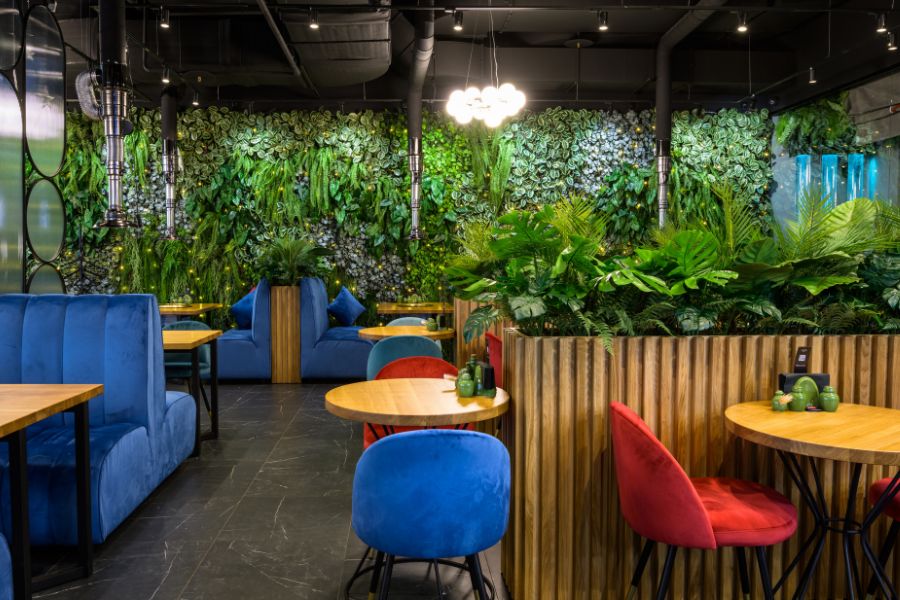
Biophilic design is all about bringing nature indoors to create spaces that are not only visually appealing but also beneficial for our well-being. Coined by biologist E.O. Wilson, biophilia describes our natural tendency to seek connections with nature. This concept forms the foundation of biophilic interior design, which aims to integrate elements of nature into built environments like restaurants.
In biophilic interior design restaurants, designers use principles such as fostering sensory experiences, creating refuge spaces, and encouraging dynamic interactions with nature. This means incorporating natural materials, like wood and stone, into the restaurant’s decor, as well as incorporating living elements like plants and water features. These elements can help improve air quality, create a sense of calm, and enhance the overall dining experience for customers.
Imagine walking into a restaurant where the walls are adorned with living greenery, natural light streams in through large windows, and the sound of flowing water adds a soothing ambiance. This is the essence of biophilic interior design restaurant spaces.
Biophilic Design Features

Natural Light Integration
Biophilic interior design restaurants focuses on bringing elements of nature into the dining space to create a more inviting and sustainable atmosphere. One key feature is maximizing natural light through large windows, skylights, and light wells. This not only reduces energy usage but also enhances the ambiance for patrons.
Use of Organic Materials
Organic materials like reclaimed wood, stone, bamboo, and cork add earthy textures and warmth to the restaurant. These sustainable choices resonate with diners who appreciate authenticity and environmental consciousness.
Incorporation of Living Elements (Plants, Water Features)
Incorporating living elements such as plants and water features is another hallmark of biophilic interior design restaurants. Plants not only purify the air but also contribute to a tranquil dining environment, while water features like fountains enhance the sensory experience.
Visual Connections with Nature
Visual connections with nature, such as strategically placed greenery and panoramic views of natural landscapes, blur the boundaries between indoor and outdoor spaces. Artistic installations inspired by natural forms further immerse patrons in a biophilic dining experience.
Spatial Configuration to Mimic Natural Environments
Finally, the spatial configuration of the restaurant may mimic natural environments with organic shapes, curvilinear pathways, and varying elevations. This fluid arrangement encourages exploration and discovery, echoing the diversity and dynamism of natural habitats. Incorporating these biophilic design features creates a welcoming and sustainable restaurant environment that connects diners with nature.
Why is Biophilic Design Important?
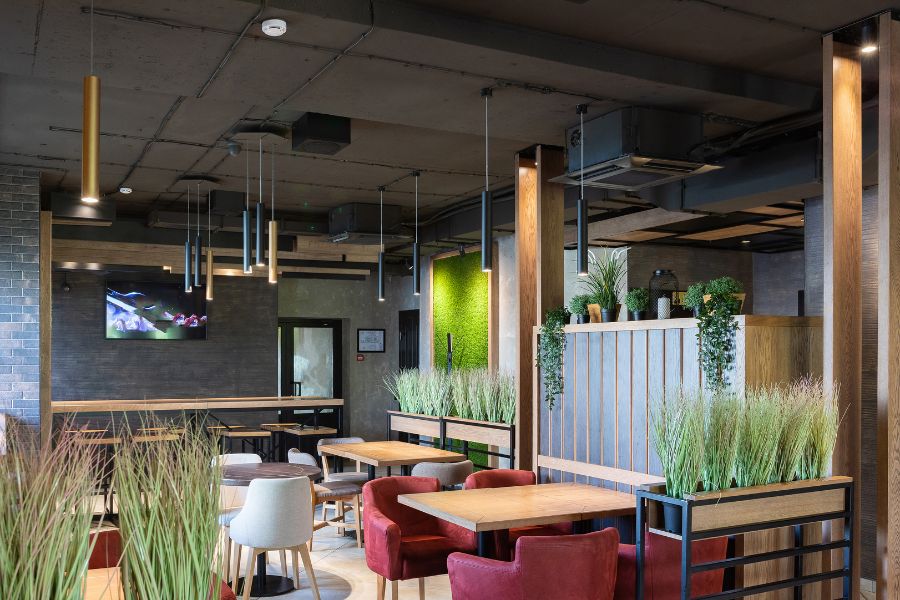
Psychological and Emotional Well-being of Diners
Biophilic interior design restaurants is important for several reasons. Firstly, it positively impacts the psychological and emotional well-being of diners. Research shows that exposure to nature, even indoors, can reduce stress and anxiety. By incorporating elements like natural light, greenery, and organic textures, restaurants can create a more pleasant dining experience for customers.
Enhancing Comfort and Relaxation
Secondly, biophilic design enhances comfort and relaxation. Features such as indoor plants and water elements help create a soothing atmosphere that encourages patrons to linger longer. This leads to increased customer satisfaction and repeat visits, ultimately benefiting the restaurant’s bottom line.
Increasing Customer Satisfaction and Loyalty
Furthermore, prioritizing biophilic design can increase customer satisfaction and loyalty. Restaurants that incorporate natural elements are often perceived as more inviting and enjoyable places to dine. This fosters a connection with the environment, making diners feel more at ease and satisfied with their experience, leading to positive word-of-mouth recommendations.
Positive Impacts on Staff Morale and Productivity
Additionally, biophilic design has positive impacts on staff morale and productivity. Studies have shown that working in environments enriched with natural elements can improve mood and concentration among employees. By creating a more pleasant workplace, biophilic interior design restaurants can reduce turnover rates and enhance overall staff morale.
Contribution to Sustainable Practices
Lastly, biophilic design aligns with principles of sustainability. By using natural materials, maximizing natural light, and incorporating energy-efficient systems, restaurants can reduce their environmental footprint and promote eco-friendly practices. This not only benefits the planet but also enhances the restaurant’s reputation as a socially responsible establishment.
How to Incorporate Biophilic Design
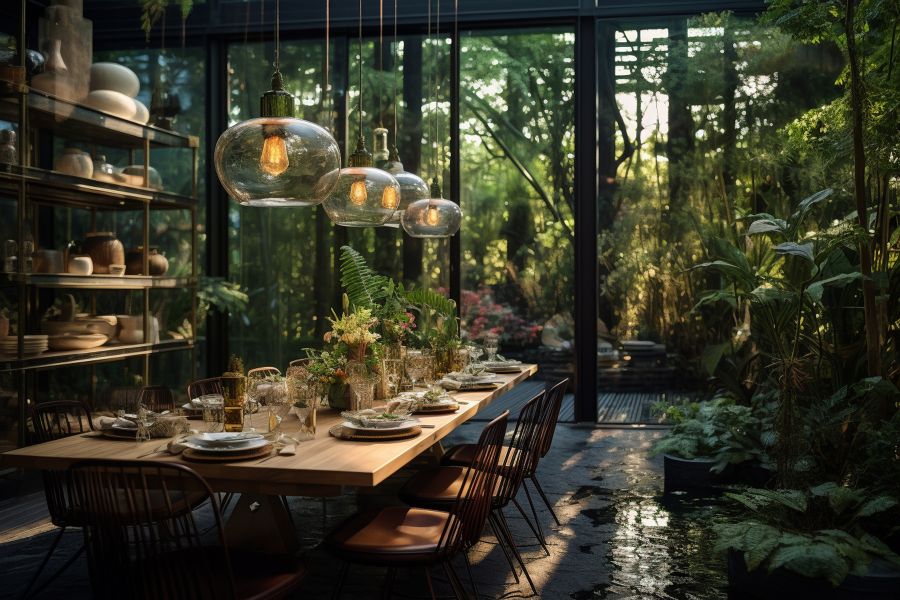
To incorporate elements into a biophilic interior design restaurant, it’s important to follow these steps:
Assess the Space: Take a good look at the restaurant’s surroundings, considering things like natural light, views of nature, and existing architectural features. This helps in understanding how biophilic elements can be integrated.
Choose Natural Elements: Once you know the space well, select appropriate biophilic elements like indoor plants, living walls, water features, natural materials, and nature-inspired artwork. These elements should enhance the restaurant’s ambiance and aesthetic.
Integrate Biophilic Elements: Incorporate these elements thoughtfully into the restaurant’s layout to create a cohesive and immersive dining experience. Consider placing plants strategically, using natural textures, and ensuring good sightlines to outdoor views.
Collaborate with Experts: Work with experienced designers and architects who specialize in biophilic interior design restaurants. They can offer valuable insights and creative solutions to effectively integrate these elements into the overall design.
Maintenance is Key: Once biophilic elements are in place, make sure to prioritize their upkeep. Regular watering, pruning of plants, cleaning water features, and inspecting natural materials are essential to keep them vibrant and healthy over time.
By following these steps, restaurant owners can successfully incorporate biophilic interior design restaurants elements into their space, creating a welcoming and nature-inspired atmosphere for their guests.
Benefits of Biophilic Design
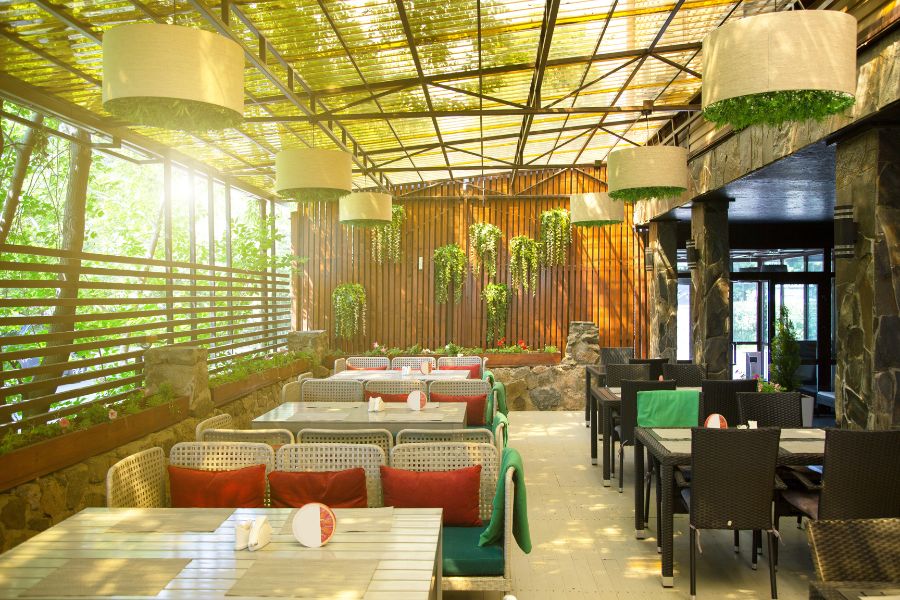
Biophilic interior design restaurants offer numerous benefits that enhance both the dining experience and the overall well-being of patrons and staff. By incorporating elements such as living green walls, indoor plants, and strategic ventilation systems, these restaurants improve air quality, creating a healthier environment for everyone. Studies have shown that exposure to natural elements like natural light and greenery can reduce stress levels and promote mental well-being, contributing to a more relaxing atmosphere for diners. Additionally, biophilic design can positively impact appetite and overall dining experience by creating a comfortable and inviting space through the use of natural textures, colors, and patterns.
Furthermore, biophilic interior design restaurants prioritize sustainability and eco-friendly design practices, utilizing reclaimed wood, recycled materials, and energy-efficient systems. By embracing environmental responsibility, these establishments not only contribute to a healthier planet but also attract environmentally conscious patrons.
Most importantly, biophilic design enhances the aesthetic appeal and ambiance of restaurants, setting them apart from traditional dining establishments. Lush greenery, natural materials, and tranquil water features create visually stunning spaces that captivate diners and provide a unique dining experience. In conclusion, the incorporation of biophilic interior design elements in restaurants offers a myriad of benefits that contribute to a healthier, more enjoyable, and aesthetically pleasing dining environment.
Restaurant Interior Color Ideas
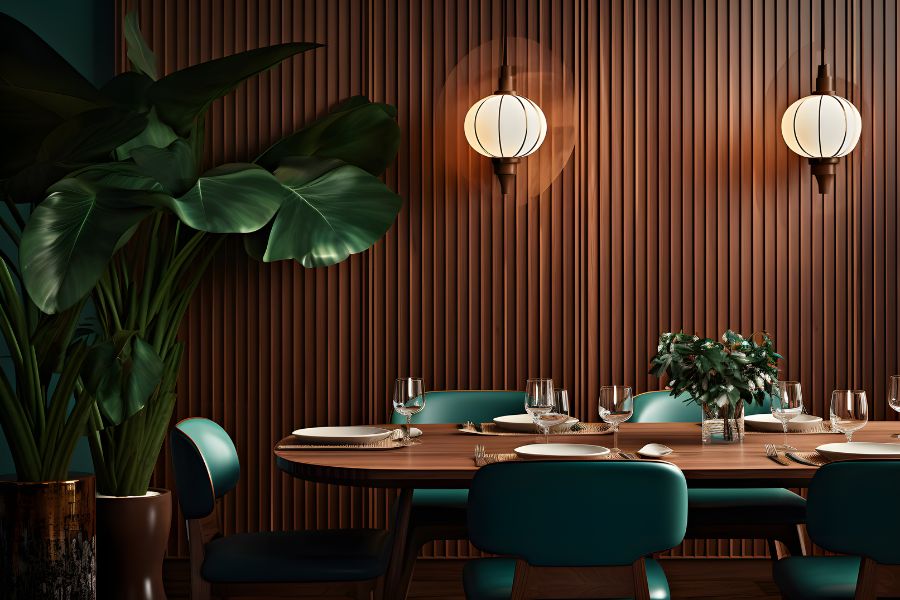
Earthy Tones and Natural Hues
If you’re looking to create a welcoming atmosphere in your restaurant while incorporating elements of nature, consider using earthy tones and natural hues in your interior design. Biophilic interior design restaurants focuses on bringing the outdoors in, so shades like green, brown, beige, and grey can help achieve that warm and inviting feel.
Incorporation of Greenery and Botanical Accents
To further enhance the connection with nature, think about incorporating greenery and botanical accents throughout your space. This could include things like potted plants, vertical gardens, or botanical artwork. These elements not only add freshness and vitality but also contribute to the overall biophilic ambiance.
Harmonizing with Biophilic Design Elements
When selecting colors for your restaurant, it’s important to consider how they will harmonize with other design elements such as natural materials, textures, and lighting conditions. Warm tones can complement wooden furniture and stone accents, while cooler hues can create a serene atmosphere, especially in areas with plenty of natural light.
Consideration of Lighting Conditions
Speaking of lighting, it’s crucial to maximize natural light wherever possible and supplement it with artificial sources that mimic daylight. This helps create a sense of warmth and brightness, enhancing the biophilic experience for diners.
Personalized Color Schemes for Different Dining Areas
In larger restaurants with multiple dining areas, you can personalize color schemes to create distinct atmospheres for different sections. Whether it’s a cozy corner with rich, earthy tones or a bright and airy space with pastel hues, tailoring the color palette to each area enhances the overall appeal and ambiance of the biophilic interior design restaurant.
Biophilic design case studies
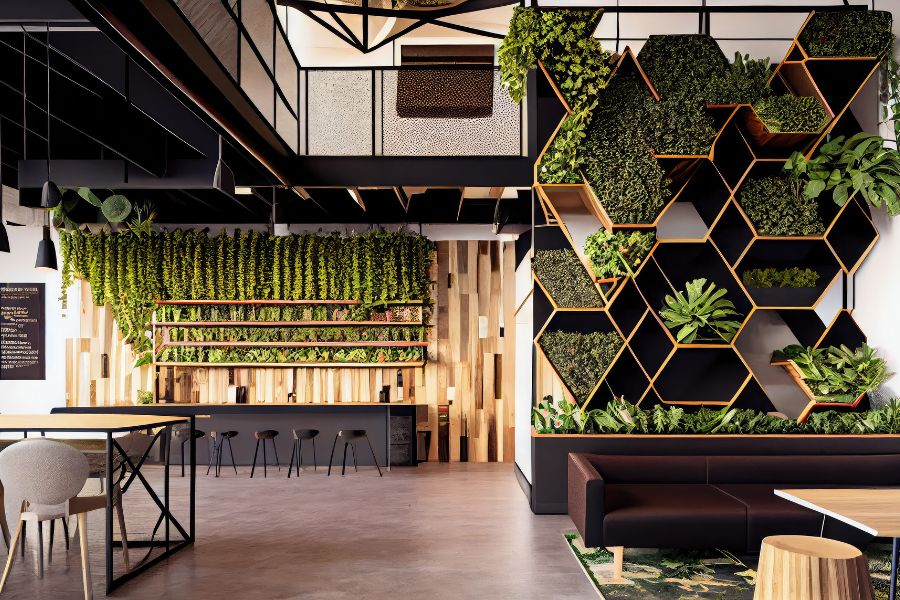
Looking at successful examples of biophilic interior design restaurants can offer valuable insights for creating inviting dining spaces that connect people with nature.
Customer feedback for biophilic interior design restaurants is overwhelmingly positive, with patrons praising the calming ambiance and expressing a desire to return. From an operational standpoint, these designs can increase foot traffic, dwell times, and employee morale, leading to higher sales and repeat business.
The success of these case studies demonstrates the adaptability of biophilic design principles to various contexts, whether urban or natural. Implementing such designs often requires collaboration between architects, interior designers, and landscapers to create truly immersive and memorable dining experiences.
Lasting Impressions
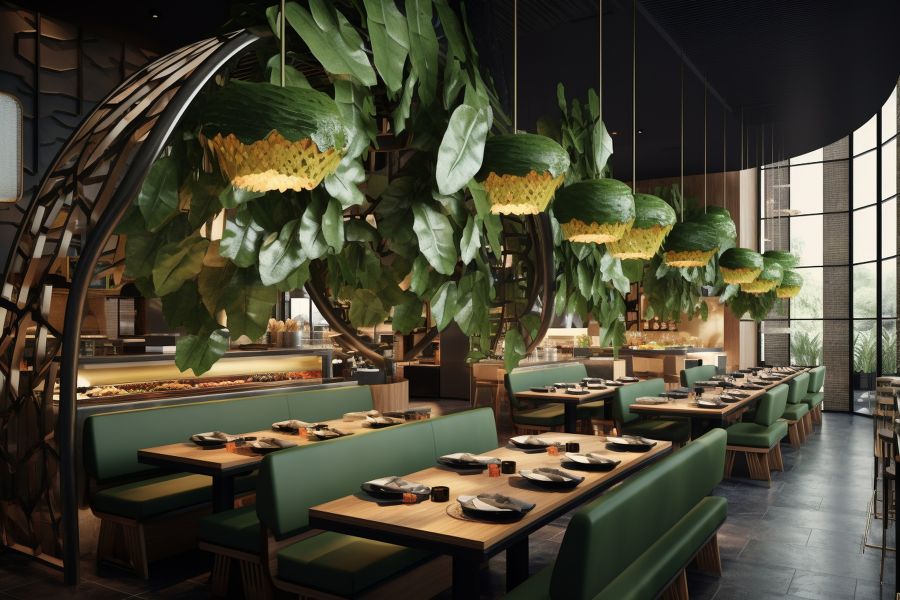
As an Interior design company, Studio A, located in Mumbai, we specialize in biophilic interior design restaurants. Our approach is centered around bringing nature indoors to craft spaces that evoke positive emotions. By embracing biophilic principles, we redefine restaurant design by emphasizing the inherent connection between humans and the natural world. Our designs not only enhance the visual appeal of restaurants but also contribute to the well-being of patrons, fostering feelings of happiness and relaxation.
Additionally, biophilic design aligns with sustainability goals, crucial for preserving the environment. As restaurants seek innovative solutions to adapt to changing trends and environmental concerns, our biophilic designs offer a compelling answer. Through thoughtful integration of elements such as plants and natural colors, we empower restaurant owners to create inviting spaces that resonate with diners, leaving a lasting impression while nurturing a deeper connection to nature.
FAQs: Frequently Asked Questions
1. What is biophilic interior design, and how does it apply to restaurants?
A. Biophilic interior design restaurant is an approach that seeks to incorporate elements of nature into built environments to enhance well-being and connection with the natural world. In restaurants, biophilic design involves integrating features such as natural light, indoor plants, organic materials, and visual connections with nature to create inviting and immersive dining spaces.
2. How does biophilic design benefit restaurant patrons?
A. Biophilic design has been shown to have numerous benefits for restaurant patrons, including reduced stress levels, improved mood, and enhanced overall dining experience. Exposure to natural elements can promote relaxation, stimulate appetite, and create a sense of well-being, contributing to a more enjoyable and memorable dining experience.
3. What are some key features of biophilic design in restaurant interiors?
A. Some key features of biophilic interior design restaurant include the integration of natural light through windows and skylights, the use of organic materials such as wood and stone, the incorporation of indoor plants and living walls, and the creation of visual connections with nature through artwork, murals, or outdoor views.
4. How can restaurants incorporate biophilic design principles into their existing spaces?
A. Restaurants can incorporate biophilic design principles into their existing spaces by assessing the layout and surroundings to identify opportunities for natural light, greenery, and natural materials. This may involve adding potted plants, installing green walls or vertical gardens, using sustainable materials in furniture and finishes, and creating focal points that draw attention to natural elements.
5. What are the benefits of using biophilic interior design restaurants?
A. The benefits of using biophilic interior design restaurants are numerous, including improved air quality, enhanced mood and well-being, increased customer satisfaction and loyalty, and a more sustainable and environmentally friendly dining experience. Biophilic design can also help restaurants stand out in a competitive market by offering a unique and memorable dining environment.
Image Reference: Freepik
Disclaimer: All trademarks, logos, and brand names are the property of their respective owners. All company, product, and service names used in this website are for identification purposes only. Use of these names, trademarks, and brands does not imply endorsement.

